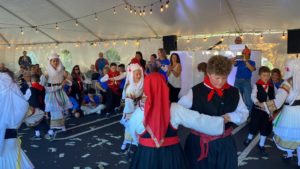Greek Dance
Welcome to Greek Dance! Dance group lessons begin in September.
Please bring both the completed Liability form and the appropriate Registration form with you on the first day of practice.
Forms are found on the links below.
Questions or concerns?
Please contact Alex Thomas
Cell: 732-216-1513 or email
Registration form and credit card payment link for Ages 8 – 12 Intermediate Group
Registration form and credit card payment link for GOYAns 7th-12th grade
 |
 |
 |
 |
 |
 |
 |
 |
 |
History of Greek Dance
Greece is one of the few countries in the world where folk dances are as alive today as they were in ancient times. Dance has always played an important role in the life of a Greek. It is an expression of human feelings and everyday life. The Greeks danced at religious festivals, ceremonies; they danced to ensure fertility; to prepare for war and to celebrate victories; they danced at weddings; to overcome depression and to cure physical illness. Almost every dance has a story to tell. Dance was regarded as one of the highest forms of art. Plato agreed that every educated man should know how to dance gracefully, by which he meant the exercises that kept the body strong and ready to do its duty on the battlefield. The weapon dance (a form of mock combat) taken from Crete and perfected in Sparta, was the ideal.
Traditional dance continues to be passed from generation to generation, which in turn maintains national identity.
EPIRUS: is especially rich in folk music. It is rugged and mountainous and the steep gorges impose heavy garments and boots. A unique characteristic of the region is the polyphonic singing. Dances from Epirus tend to be slow and heavy and danced with immense dignity. The main dances are Sta Tria, Sta Duo, Kalamatianos, Tsamikos, Zagorisios, Menousis, Koftos, Fisouni, Kentimeni Podia, Pogonisios, Fezodervenayias, Vasilo Arhontissa and Yiatros.
MACEDONIA: It is very mountainous with small valleys. Macedonia has an especially rich folk culture. The main dances are Gaida, Leventikos, Nikolos, Akritikos, Baidouska, Partalos, Kastorianos, Omorfoula, Nizamikos, Sire Sire, Boimitsa, Antikristos and Mikri Eleni.
THRACE: Western Thrace was united with Greece in 1923. Eastern Thrace today falls in Turkey and Bulgaria. Thrace is particularly rich in dancing with a wide variation in hand holding positions. Their dances are lively and generally energetic. The instruments common to this region are the bagpipe (gaida) and the lyra. The most popular dances are Zonaradikos, Souflioutouda, Apadiasteite sto Xoro, Kastrinos, Sfarlis, Syngathistos, Podaraki, Stis Treis and Baintouska.
THESSALY: United with Greece in 1881.Thessaly retains a strong tradition of song-dances where the dancers sing the music, often without instrumental accompaniment . The dances are slow and controlled. The main dances are Sta Tria, Kalamatianos, Klistos, Svarniara, Karagouna, Tai-Tai and Pilioritikos.
ROUMELI: Roumelian dances tend to be slow and controlled. The clarinet is the main instrument in this region. The main dances of this region are Tsamikos, Sta Tria, Mazochto and Kangeli
PELOPONNESUS: It was in Peloponnesus that in 1821 the struggle began to free Greece from the Ottoman rule and is the oldest part of modern Greece as we know it today. Their main dances are Kalamatianos, Tsakonikos and Kariatidon.
AEGEAN ISLANDS: The music of these islands is very delightful and lyrical and as such portrayed in its dances. These are characterized by the lightness of steps and the springing in the knees. Most frequently danced are Ballos, Sirtos, Hasapikos, Karsilamas, Sousta, Trata, Stavrotos, Chiotikos and Ikariotikos.
DODECANESE ISLANDS: Dodecanese means the twelve islands. Their music and dance were influenced by the Cretans who immigrated, fleeing from the Turks. Dances from this area include Sirtos, Ballos, IssIos, Sirtos and Sousta
IONIAN ISLANDS: Also known as Eptanisa, meaning the seven islands, Their dances are Venetian influenced. The people from Corfu are particularly musical. The dances are graceful, flirtatious and sometimes with erotic swaying of movement. Kefallonians are noted for their humor which is portrayed in their dancing. Most frequently danced are Sirtos Ai Yiogis, Fourlana, Ballos, Kerkyraikos,Thiakos and Tsirigotikos.
CRETE: Their music and dance is dynamic and fast. Each Cretan dance gives an opportunity for each dancer to lead and improvise. A particular characteristic of the Cretan dances is the springing movement of the dancers. Their most popular dances are Pentozalis, Maleviziotikos, Haniotikos, Laziotikos and Sousta.
CYPRUS: An island in the far Mediterranean sea with the majority of its inhabitants of Greek origin, language, culture and traditions, Its music and dance are quite distinctive. The most popular dances are men’s Kartsilamadhes, and the women’s Kartsilamadhes, Sirtos, Zeimbekikos, Dachas and Sousta.
PONTUS: The region of present day Turkey, an area inhabited by Greeks from ancient times till 1924. Pontic music and dance is quite distinctive. Its music and dance is easily recognized by its energy, their use of knee bends and unusual shoulder tremors, are unique to Pontus. The main dances are Tik, Omal, Kotsari, Kots, Trygona, Gerasaris and Serra.
KAPADOKIA: Lies in present day central Turkey. It was an important centre of Byzantium and the home to St Basil and St Gregory. It was one of the first areas to fall under the Ottoman Empire and so their music and dance traditions are the same as most of central Anatolia, e.g. the Spoon Dances. They also have a tradition of ritual line dances closely associated with the church calendar, e.g. Ayios Vasiliatikos. The other well known dance is the Dance of the Scarves and Karsilamas
CONSTANTINOPLE: The fall of Constantinople in 1453 saw the beginning of the Ottoman Empire, now, present day Turkey. It was in this area that three of the most popular dances often referred to as Pan Hellenic dances originated. These are the Hasapikos, Karsilamas and Zeimbekikos.